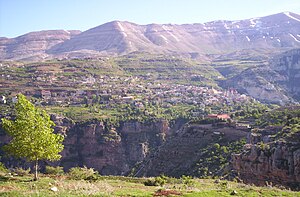Qadisha
 |
|
| UNESCO World Heritage Site | |
|---|---|
| Location |
Lebanon |
| Criteria | iii, iv |
| Reference | 850 |
| Coordinates | 34°16′59″N 35°57′06″E / 34.28294°N 35.95161°E |
| Inscription | (Unknown Session) |
|
[]
|
|
Coordinates: 34°16′58.60″N 35°57′5.84″E / 34.2829444°N 35.9516222°E
Kadisha Valley (Arabic: وادي قاديشا), also romanized as the Qadisha Valley and also known as the Kadisha Gorge or Wadi Kadisha (French: Ouadi Qadisha), is a gorge that lies within the Becharre and Zgharta Districts of the North Governorate of Lebanon. The valley was carved by the Kadisha River, also known as the Nahr Abu Ali when it reaches Tripoli. Kadisha means "Holy" in Aramaic, and the valley, sometimes called the Holy Valley. It has sheltered Christian monastic communities for many centuries. The valley is located at the foot of Mount al-Makmal in northern Lebanon.
The integrity of the Valley is at risk due to encroachment of human settlements, illegal building and inconsistent conservation activity. Although it is not yet on the UNESCO "in danger" list, there have been warnings that continued violations may lead to this step.
The holy river, Nahr Qadisha, runs through the valley for 35 km from its source in a cave (grotto) a little way below the Forest of the Cedars of God. The sides of the valley are steep cliffs that contain many caves, often at more than 1000m and all difficult of access. The most scenic section of the valley stretches for approximately twenty kilometers between Bsharri (بشري), the hometown of Kahlil Gibran, and Tourza (طورزا).
...
Wikipedia

